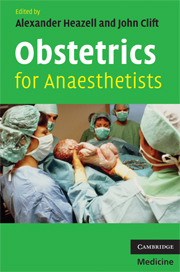Book contents
- Frontmatter
- Contents
- List of contributors
- Foreword
- Preface
- Acknowledgements
- List of abbreviations
- 1 Maternal physiology and obstetrics
- 2 Antenatal care
- 3 Induction of labour
- 4 Normal labour
- 5 Abnormal labour
- 6 Fetal monitoring
- 7 Pre-eclampsia and hypertensive disorders of pregnancy
- 8 Operative obstetrics
- 9 Obstetric haemorrhage
- 10 Thromboembolic disorders of pregnancy
- 11 Infection
- 12 Life support in obstetrics
- 13 Drugs in obstetrics
- 14 Confidential enquiries into fetal, neonatal and maternal death
- Appendix 1 Adult Advanced Life Support Algorithm
- Appendix 2 The Management of Postpartum Haemorrhage Algorithm
- Appendix 3 Emergency Management of Eclamptic Fit Algorithm
- Index
- References
3 - Induction of labour
Published online by Cambridge University Press: 21 August 2009
- Frontmatter
- Contents
- List of contributors
- Foreword
- Preface
- Acknowledgements
- List of abbreviations
- 1 Maternal physiology and obstetrics
- 2 Antenatal care
- 3 Induction of labour
- 4 Normal labour
- 5 Abnormal labour
- 6 Fetal monitoring
- 7 Pre-eclampsia and hypertensive disorders of pregnancy
- 8 Operative obstetrics
- 9 Obstetric haemorrhage
- 10 Thromboembolic disorders of pregnancy
- 11 Infection
- 12 Life support in obstetrics
- 13 Drugs in obstetrics
- 14 Confidential enquiries into fetal, neonatal and maternal death
- Appendix 1 Adult Advanced Life Support Algorithm
- Appendix 2 The Management of Postpartum Haemorrhage Algorithm
- Appendix 3 Emergency Management of Eclamptic Fit Algorithm
- Index
- References
Summary
Introduction
Induction of labour is defined as an intervention to artificially initiate uterine contractions to lead to cervical effacement and dilatation, and delivery of the baby. This definition incorporates women with intact membranes and those with spontaneous rupture of membranes who have not gone into labour. In the UK, about 20% of pregnancies are induced.
Indications for induction of labour
The indications for induction of labour (IOL) can be divided into fetal or maternal indications. It is important that IOL is initiated for a specific indication, due to the associated risks. The benefits of delivery should outweigh the risks of continuing the pregnancy.
Fetal
Post maturity
Prolonged pregnancy is the most common indication for IOL. Guidelines from the National Institute for Health and Clinical Excellence (NICE) recommend offering IOL to women between 41 and 42 weeks' gestation. This gestation is utilised due to the risk of stillbirth rising from 1 per 1000 pregnancies at 42 weeks to 2 per 1000 pregnancies at 43 weeks. Prolonged gestation can also be associated with an increase in intrapartum complications such as fetal distress.
Suspected fetal compromise
Suspected fetal compromise may be an indication for IOL. Placental insufficiency including intrauterine growth restriction (IUGR), reduced liquor volume, or an abnormal Doppler ultrasound of the umbilical artery is an indication for delivery of the baby, as is rhesus incompatibility where the fetus may be at risk of anaemia.
Keywords
- Type
- Chapter
- Information
- Obstetrics for Anaesthetists , pp. 22 - 30Publisher: Cambridge University PressPrint publication year: 2008

